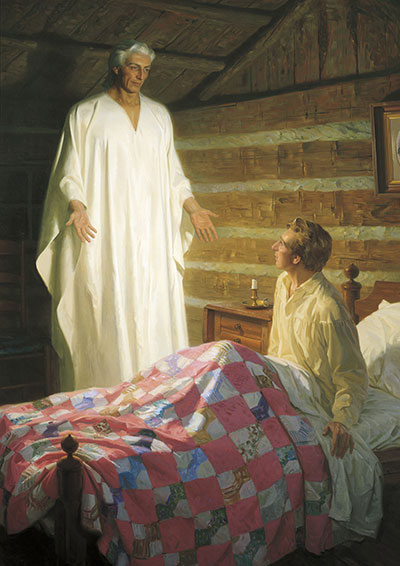2 Nephi 21-22 (10/23)
Reading Assignment: 2 Nephi 21-22
Learning Activity:
Pause for a moment, and imagine a light beginning to appear before you. The light becomes brighter and brighter. Suddenly a messenger sent from the presence of God is standing in front of you. He tells you that ancient prophecies are about to be fulfilled and that you will help in their fulfillment. What would be your initial reactions, thoughts, and questions?
Moroni Appears to Joseph Smith in His Room
On the night Moroni first appeared to Joseph Smith—September 21, 1823—he quoted Isaiah 11, which is also found in 2 Nephi 21. Moroni told Joseph Smith that the prophecies in that chapter were about “to be fulfilled” (Joseph Smith—History 1:40). As you study these prophecies from Isaiah, reflect upon why Nephi would record them on the small plates and also why Moroni would quote them to Joseph Smith.
The Prophet Joseph Smith received a revelation that clarified the meaning of the prophecies recorded in 2 Nephi 21. Scholars have long been fascinated with trying to understand the meaning of the symbols used in this chapter. The Book of Mormon and modern prophets have helped us better understand the meaning. For example, Isaiah used the imagery of a tree or plant. Read 2 Nephi 21:1, 10, and identify the specific parts of the tree or plant Isaiah mentioned. Then read Doctrine and Covenants 113:1–6 to help you understand what these symbols mean. It may be helpful to write the interpretations of the symbols in your scriptures.
- Stem of Jesse—Jesus Christ
- Rod out of the stem of Jesse—A servant of Jesus Christ
- Root of Jesse—An individual who holds priesthood keys
Consider the following statement by Elder Bruce R. McConkie, who explained that the “root of Jesse” and the “rod out of the stem of Jesse” both refer to the Prophet Joseph Smith: “Are we amiss in saying that the prophet here mentioned [in D&C 113:5–6] is Joseph Smith, to whom the priesthood came, who received the keys of the kingdom, and who raised the ensign for the gathering of the Lord’s people in our dispensation? And is he not also the ‘servant in the hands of Christ, who is partly a descendant of Jesse as well as of Ephraim, or of the house of Joseph, on whom there is laid much power’? [D&C 113:3–4]” (Millennial Messiah [1982], 339–40).
Read 2 Nephi 21:10, 12, and look for what Isaiah prophesied the Lord would do through the “root of Jesse” (Joseph Smith). The word ensign refers to a “standard” to which people gather.
- In 2 Nephi 21:6–9; 22:1–6 Isaiah describes the Millennium. What is your favorite part?
Want More?
Using Scripture to Understand Scripture
Our books of scripture work together to help us understand gospel truths and prophecies. For example, this lesson refers to Doctrine and Covenants 113 to help clarify prophecies and teachings of Isaiah. Nephi also helped us understand Isaiah’s words. Elder Bruce R. McConkie of the Quorum of the Twelve Apostles observed that “the Book of Mormon is the world’s greatest commentary on the book of Isaiah” (“Ten Keys to Understanding Isaiah,” Ensign, Oct. 1973, 81).
 Why Did Moroni Quote Isaiah 11 to Joseph Smith? Watch the video, read the article, listen to the podcast.
Why Did Moroni Quote Isaiah 11 to Joseph Smith? Watch the video, read the article, listen to the podcast.